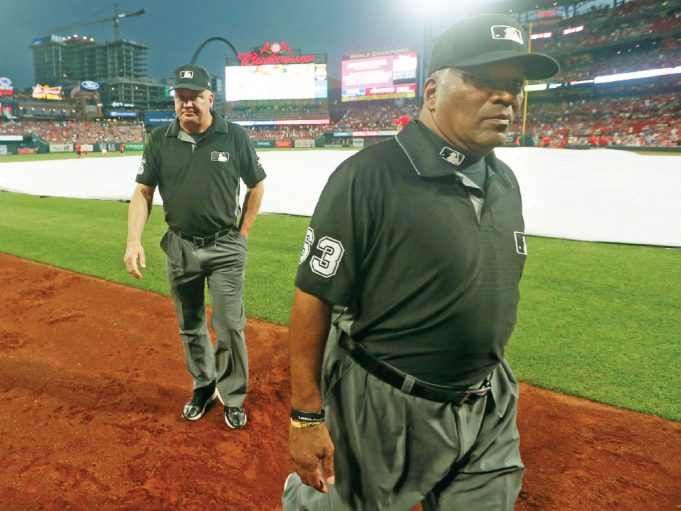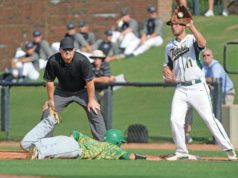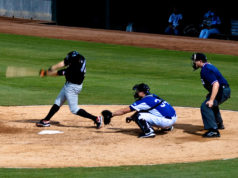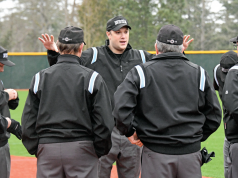M
any an umpire could undoubtedly double as a meteorologist if it ever became necessary. The only thing we seem to study more than the rulebook is the weather forecast, fully aware that playing an outdoor sport throughout the spring and summer means, in just about every part of the country, trying to dance around and through raindrops, lightning and more.
It would be wonderful if we could just close our eyes, sing the refrain from a well-known children’s song — “Rain, rain, go away, come back again some other day” — and put the ball back in play. But it’s never that simple.
We need to have a game plan for bad weather every time we take the field — and that plan needs to be a living, breathing philosophy that can quickly adapt and change based on all of the information available to us. It’s about so much more than whether or not liquid sunshine is actually falling from the sky.
We’ve all heard the term, “minding your p’s and q’s.” This past fall, during an offseason umpiring camp, I was fortunate to listen to a presentation by Brent Rice, the former lead instructor at the Wendlestedt Umpiring School and currently the director of officiating and baseball for the Michigan High School Athletic Association, about “minding your p’s and f’s” when it comes to weather and making decisions regarding postponing or suspending play.
The first thing to remember is the decision about whether to start a game, by rule, rests with the coach of the home team (NFHS 4-1-1; NCAA 5-1; pro 4.04a). And let’s face it, coaches are human. One who needs a win in the worst way to qualify for postseason play is likely to be much more willing to ignore some puddles on the warning track and behind home plate than one whose team is just playing out the string and doesn’t want to be there. But until the ball is put in play to start the game, what the coach says, goes.
From that moment onward, it’s completely in the umpiring crew’s hands, whether we like it or not. It’s not an enviable position, and plenty of umpires have grappled with the “should we or shouldn’t we?” dilemma as the rain falls harder or the lightning inches closer.
Thus, the “p’s” and “f’s” that should serve as a road map to help us arrive at a reasonable decision:
Field conditions
What makes for a safe field and for one that isn’t suitable for play? That’s a moving target that features plenty of variables. It ultimately comes down to the umpires’ discretion, which should begin to be developed as soon as a crew walks on the field. Again, the home coach has the benefit of deciding whether or not the game will start. However, the umpires are well within their rights to believe said coach is making a dangerous decision to put the teams on the field given its condition at the time of the first pitch.
If your crew honestly believes a field is not safe for play, there is nothing stopping you from suspending play immediately after the home-plate umpire signals “Play” to start the game. And from that point forward, if you notice anything related to the condition of the field that makes you believe the right choice is to pull the teams off the field, you have that right by rule.
Areas to keep a close eye on include, first and foremost, the pitcher’s mound and the home-plate area. If pitchers, catchers, hitters and the home-plate umpire cannot get good footing because the dirt is now mud, it’s your call about determining whether this is a minor hindrance or necessitates taking a break from the action.
Next, move to other areas of possible concern. Are the basepaths and the infield dirt safe for play? What about the infield and/or outfield grass? How about the warning track and the area in front of the dugouts? Remember, not all fields are designed in the same manner and with the same engineering. You may find yourself on a diamond where the mound and plate area are not a problem, but the right fielder is standing in water up to his ankles. Be aware of the weather-related safety concerns on the entire field — not just the little patch of dirt or grass that you call home.
Precipitation
Not everything that falls from the sky affects players and the ability to play the game the same way. As an umpiring crew, you need to be able to recognize whether the rain or snow is creating an unfair and unsafe playing environment, and you need to also recognize that not every situation calls for the same solution.
A steady drizzle may not seem like much of a hindrance and may not even make a significant impact on the playing field. However, it could pose problems for a pitcher or another fielder trying to grip the baseball, or a batter to grip the bat. On the other hand, a quick burst of heavy rain may necessitate pulling players off the field for just a few minutes as a fast-moving storm passes through.
Meanwhile, any type of snowfall can create all sorts of second-guessing. I first learned this lesson as a player. I grew up in Southern California, so I barely had ever seen snow throughout my first 18 years. So imagine my surprise when, during one of my college games in central Utah, we were hit with a snowstorm, and everyone’s response was to hang tight in the locker room rather than calling it a day.
Sure enough, as soon as the snow stopped, we grabbed brooms, swept the outfield and resumed play. The soft, fluffy flakes did not contain that much water, so the field remained suitable for play as soon as the white stuff stopped falling.
Forecast
Good umpires always keep an eye on the weather forecast for a significant window of time on game day. They not only need to know what’s expected before the game starts and once they take the field, but for the remainder of the day, should there be a need to resume play following a lengthy interruption.
Technological advances now allow umpires access to real-time radar on the field and to know whether there is a three-hour window during which a game could be started and completed, or just 20 minutes before the next thunderstorm is expected to arrive. This same technology can be used to keep the crew informed about whether there is lightning in the area, which creates its own set of safety requirements.
Of course, as we all know, forecasts aren’t foolproof. Umpires still need to trust their own eyes with what is happening on the field. However, the more tools and information we can use to make sound decisions, the better.
Personnel
Being able to continue or resume a game when weather becomes a factor isn’t just about what’s falling from the sky. It is every bit as important to understand who is available to help counteract the issues the precipitation is creating or has created.
A location with a dedicated grounds crew is going to have much more success keeping a game on track in wet conditions than one where the coaching staff and players are expected to fulfill this role. If there are a dozen people on hand to pull on a tarp as soon as the hard stuff starts falling, or to attack wet spots with bags of “Diamond Dry” when puddles form, you stand a much better chance of keeping the field playable, even if it means the occasional delay.
Again, I go back to my own playing days in college. At my first school, we had a half-dozen or so field crew personnel who worked in conjunction with the players to get the tarp on and off the field and who tackled any weather-created issues. At my second school, it was completely on the players to do the work. There were far fewer issues with the former as compared to the latter.
As an umpiring crew, if you are working a game where you know weather may become a factor, speak with game administration before taking the field so that you will have a full understanding of what personnel will be available to help combat any problems. This information could play into your decision-making about when to pull teams off the field, knowing what type of help will ultimately be available to keep the field playable as the day progresses.
Facilities
Finally, just as all weather and the people available to handle it are not equal, the same holds true for facilities. Understanding the field you are working on for any given day is an important part of the puzzle.
Is the field a traditional grass-and-dirt design, or is it a partial or complete artificial surface? Does it feature good drainage, or was it built 50 years ago, never updated and prone to standing water with the first good shower? Are there plenty of sturdy tarps to cover the infield, pitcher’s mound and plate area, or just one ratty piece of fabric rolled up along the fence that is going to be expected to do the trick?
Fields with lots of dirt are always going to pose more of a challenge when the wet stuff falls. Artificial turf fields may become slick with the slightest precipitation, but may return to quick playability after a sturdy storm passes.
Umpires also need to be aware of protecting participants in the case of lightning. A fully functional stadium with locker rooms is going to offer a different level of safety than a field surrounded by metal bleachers with no place for players, coaches or umpires to go other than the dugouts.
Whenever lightning is visible, umpires need to halt play and get everyone off the field. However, your readiness to make that decision may be additionally heightened if you realize the field you are working on does not offer much protection once a storm hits.
What's Your Call? Leave a Comment:
Note: This article is archival in nature. Rules, interpretations, mechanics, philosophies and other information may or may not be correct for the current year.
This article is the copyright of ©Referee Enterprises, Inc., and may not be republished in whole or in part online, in print or in any capacity without expressed written permission from Referee. The article is made available for educational use by individuals.



















